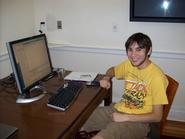
If you've ever seen a Roomba vacuum cleaner, you know that it's a pretty cool gadget. Not only does it rid your carpet of grime, but infrared sensors help navigate its way around your living room. This summer, Tom Williams '11 will play with robots that look just like these, except they're not mini-maids. They're designed to think and deduce like humans.
Williams says he has been interested in artificial intelligence for a long time, and is excited to work on this summer project with Associate Professor of Computer Science Alistair Campbell. His research is only a segment of a more extensive project currently in the works at SUNY Buffalo. Williams has begun to work with SNePS, a knowledge representation, reasoning and acting (KRRA) system. In other words, SNePS (Semantic Network Processing System) is an artificial intelligence code that Williams will use to create a robot that mimics human logic and thought processes.
Most computer scientists prefer to use the programming language known as LISP for their research in artificial intelligence. Williams, too, will use this language to program commands, goals, and actions. The robots will be able to interpret clues from a logic puzzle to solve various problems. It will emulate human inference by running through plans and procedures with a certain goal in mind.
Until he can actually build the robot, Williams spends much of his time programming and researching. Pyrobot Simulator is a program that allows him to watch an animated, 2-D robot analyze its surroundings using SONAR. Much of computer programming requires experimentation – Williams will have to fiddle with different landscapes and mazes for the robot to assess, and he will need to write codes to communicate with the robot.
However, he and Campbell have encountered a conflict between coding languages. SNePS uses LISP to communicate, whereas Pyrobot Simulator uses Python. It's a minor detail, but could block them from getting the best results. Williams will try to find a small thread of similarity between the two so that the language is easily translatable.
For the past two summers, Williams worked with Cyber Forensics at the U.S. Air Force, but this summer, he wanted to do something more hands-on. The individualized aspect of his study will help him learn more about computer science and how it is applied in real life.
To those who are interested in artificial intelligence, Williams recommends the Pulitzer Prize-winning book, Gödel, Escher, and Bach: An Eternal Golden Braid by Douglas Hofstadter. The title is somewhat deceiving – the central theme of the book is not about math, art, or music, but cognition.
In the words of the author, it is a "metaphorical fugue on minds and machines." Williams says this book proved highly interesting and further grounded his interest in artificial intelligence and cognitive systems. After Hamilton, he plans to go on to graduate school for computer science.
Williams is a graduate of Clinton Senior High School.
Williams says he has been interested in artificial intelligence for a long time, and is excited to work on this summer project with Associate Professor of Computer Science Alistair Campbell. His research is only a segment of a more extensive project currently in the works at SUNY Buffalo. Williams has begun to work with SNePS, a knowledge representation, reasoning and acting (KRRA) system. In other words, SNePS (Semantic Network Processing System) is an artificial intelligence code that Williams will use to create a robot that mimics human logic and thought processes.
Most computer scientists prefer to use the programming language known as LISP for their research in artificial intelligence. Williams, too, will use this language to program commands, goals, and actions. The robots will be able to interpret clues from a logic puzzle to solve various problems. It will emulate human inference by running through plans and procedures with a certain goal in mind.
Until he can actually build the robot, Williams spends much of his time programming and researching. Pyrobot Simulator is a program that allows him to watch an animated, 2-D robot analyze its surroundings using SONAR. Much of computer programming requires experimentation – Williams will have to fiddle with different landscapes and mazes for the robot to assess, and he will need to write codes to communicate with the robot.
However, he and Campbell have encountered a conflict between coding languages. SNePS uses LISP to communicate, whereas Pyrobot Simulator uses Python. It's a minor detail, but could block them from getting the best results. Williams will try to find a small thread of similarity between the two so that the language is easily translatable.
For the past two summers, Williams worked with Cyber Forensics at the U.S. Air Force, but this summer, he wanted to do something more hands-on. The individualized aspect of his study will help him learn more about computer science and how it is applied in real life.
To those who are interested in artificial intelligence, Williams recommends the Pulitzer Prize-winning book, Gödel, Escher, and Bach: An Eternal Golden Braid by Douglas Hofstadter. The title is somewhat deceiving – the central theme of the book is not about math, art, or music, but cognition.
In the words of the author, it is a "metaphorical fugue on minds and machines." Williams says this book proved highly interesting and further grounded his interest in artificial intelligence and cognitive systems. After Hamilton, he plans to go on to graduate school for computer science.
Williams is a graduate of Clinton Senior High School.
